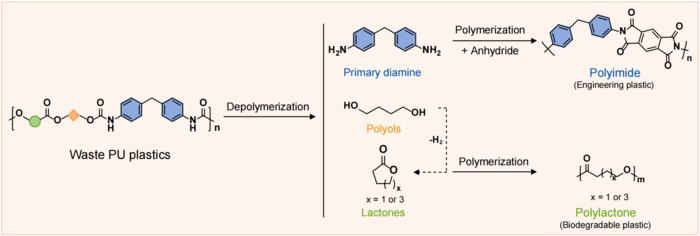The modern world faces a significant environmental challenge: the accumulation of plastic waste, particularly the persistent and complex polymer known as polyurethane. Scientists are continually searching for effective ways to tackle this issue, and a groundbreaking study led by Professors Ding Ma and Meng Wang at the Beijing National Laboratory for Molecular Science has found a promising approach. Their research unveils a pioneering upcycling method that not only recycles polyurethane waste but also transforms it into valuable, functional materials.
Polyurethane is widely used in various industries due to its desirable properties, such as flexibility and durability, but its non-biodegradable nature creates serious pollution challenges. Traditional methods to manage polyurethane waste often involve incineration, which can lead to harmful emissions, or landfilling, which perpetuates environmental degradation. As a result, developing more sustainable and efficient methods of waste management is urgent. This study’s findings contribute critical advancements in this arena, presenting a feasible solution that enhances the value of plastic waste rather than discarding it.
At the heart of the research is a carefully engineered heterogeneous catalytic system capable of transforming polyurethane waste into valuable intermediates. Through this innovative approach, the research team effectively addresses not just the disposal of waste but its conversion into useful chemicals and materials. The first step of the process involves catalytic depolymerization, where the team employed an effective mixture of CO2 and H2. This ingenious method serves as a reaction medium that facilitates the breakdown of polyurethane waste into fundamental building blocks, including diamines, diols, and lactones.
The efficiency of the catalytic process is remarkable. The team achieved a total product yield of 86% using a unique inverse ZnO-ZrO2/Cu catalyst at a temperature of 200 degrees Celsius. This indicates that the method not only successfully breaks down polyurethane but does so with minimal energy input, underscoring its sustainability. The effectiveness of this catalyst lies in its dual functionality; it expedites the conversion of carbon dioxide into methanol while simultaneously catalyzing the hydrogenation reaction necessary for plastic depolymerization.
Once the team secured a source of diamines and lactones, they proceeded to the upcycling phase. The purified intermediates were employed to synthesize high-performance polymers, specifically polyimide and polylactone. The polyimide film produced during this stage showcased exceptional energy-storage capabilities, making it a potential candidate for applications in energy-related technologies. On the other hand, the synthesized polylactone displayed both satisfactory chemical recyclability and impressive ductile properties, paving the way for its use in various commercial sectors.
The application of this developed upcycling strategy goes beyond addressing the immediate problem of polyurethane waste. It represents a paradigm shift in how we perceive and utilize plastic waste. By creating functional and valuable materials from what was once considered mere refuse, the research aligns with the principles of a circular economy. This approach highlights the importance of recycling and reusing materials to minimize waste and reduce environmental impact.
As the global community grapples with the repercussions of plastic pollution, the implications of this study may empower researchers and industries to pursue similar strategies for other types of plastic waste. The ability to convert used materials into high-value products holds enormous potential, heralding new approaches to recycling technologies and sustainable manufacturing. This could be particularly critical as governments and organizations seek to implement more stringent policies against plastic waste.
In a world where the effects of climate change and plastic pollution are becoming increasingly evident, research endeavors such as these serve as a beacon of hope. They not only demonstrate the potential for science and technology to solve complex problems but also invite collaboration across fields. From academia to industry, the responsibility to innovate sustainably falls on everyone, and the success of the upcycling process developed by Ma and Wang could inspire further research initiatives aimed at addressing the global waste crisis.
The results of their study are published in the reputable journal National Science Review. The significance of this work cannot be overstated, as it points toward the future of material science and environmental chemistry. By harnessing waste and transforming it into valuable products, researchers are crafting a narrative of sustainability. This transformative approach highlights a pressing need for a conscious shift in how we manufacture and consume materials today.
In conclusion, the research led by Professors Ding Ma and Meng Wang stands as a significant milestone in the quest for sustainable solutions to plastic waste management. Through innovative catalytic strategies and the creation of valuable polymers, they showcase a novel means of contributing to both economic and environmental sustainability. Their efforts exemplify the critical intersection of science and societal needs, setting the stage for future advancements in sustainable material science.
Subject of Research: Upcycling of polyurethane waste into valuable polymers
Article Title: Chemical transformation of polyurethane into valuable polymers
News Publication Date: [Not Provided]
Web References: https://doi.org/10.1093/nsr/nwae393
References: [Not Provided]
Image Credits: ©Science China Press
Keywords
Upcycling, polyurethane waste, catalytic depolymerization, functional polymers, sustainability, circular economy, polyimide, polylactone, environmental chemistry, material science.





